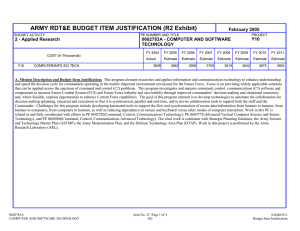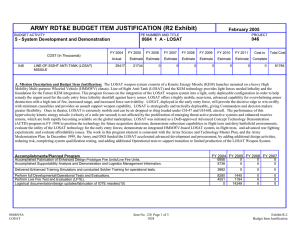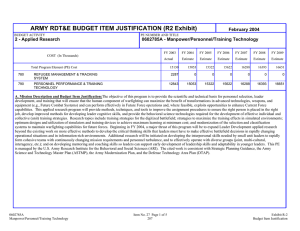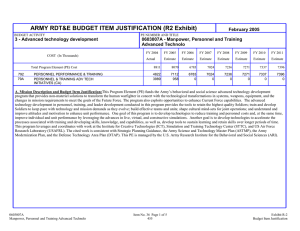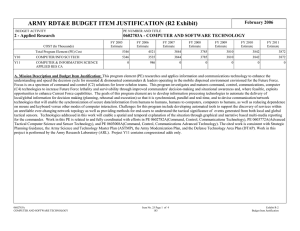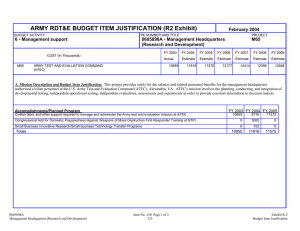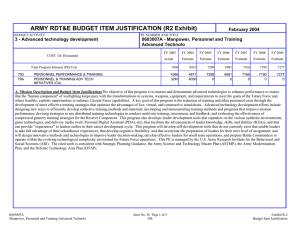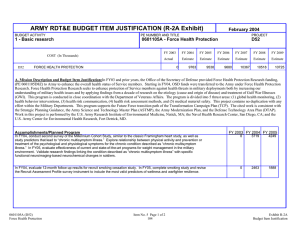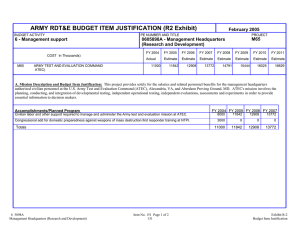ARMY RDT&E BUDGET ITEM JUSTIFICATION (R2 Exhibit) February 2006
advertisement
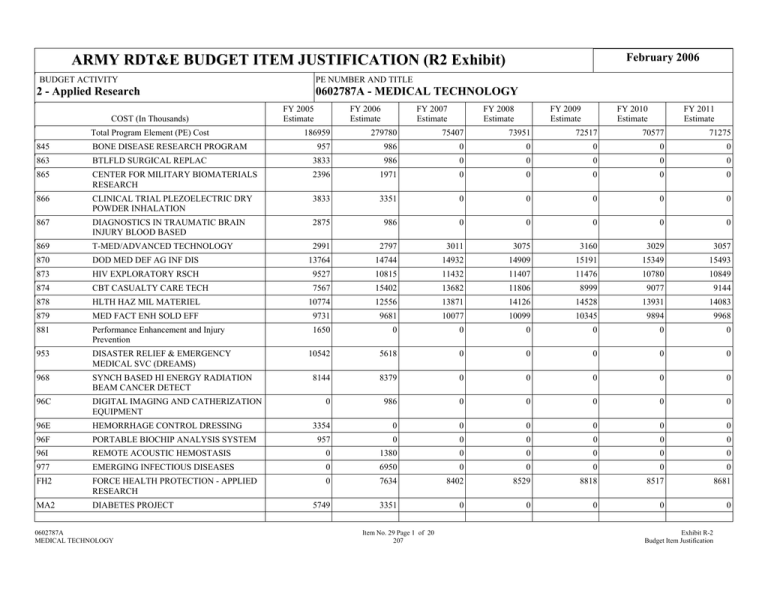
February 2006 ARMY RDT&E BUDGET ITEM JUSTIFICATION (R2 Exhibit) Budget Item Justification Exhibit R-2 BUDGET ACTIVITY PE NUMBER AND TITLE 2 - Applied Research 0602787A - MEDICAL TECHNOLOGY 0602787A MEDICAL TECHNOLOGY COST (In Thousands) Total Program Element (PE) Cost FY 2005 Estimate FY 2006 Estimate FY 2007 Estimate FY 2008 Estimate FY 2009 Estimate FY 2010 Estimate FY 2011 Estimate 186959 279780 75407 73951 72517 70577 71275 957 986 0 0 0 0 0 845 BONE DISEASE RESEARCH PROGRAM 863 BTLFLD SURGICAL REPLAC 3833 986 0 0 0 0 0 865 CENTER FOR MILITARY BIOMATERIALS RESEARCH 2396 1971 0 0 0 0 0 866 CLINICAL TRIAL PLEZOELECTRIC DRY POWDER INHALATION 3833 3351 0 0 0 0 0 867 DIAGNOSTICS IN TRAUMATIC BRAIN INJURY BLOOD BASED 2875 986 0 0 0 0 0 869 T-MED/ADVANCED TECHNOLOGY 2991 2797 3011 3075 3160 3029 3057 870 DOD MED DEF AG INF DIS 13764 14744 14932 14909 15191 15349 15493 873 HIV EXPLORATORY RSCH 9527 10815 11432 11407 11476 10780 10849 874 CBT CASUALTY CARE TECH 878 HLTH HAZ MIL MATERIEL 879 881 953 DISASTER RELIEF & EMERGENCY MEDICAL SVC (DREAMS) 968 SYNCH BASED HI ENERGY RADIATION BEAM CANCER DETECT 96C DIGITAL IMAGING AND CATHERIZATION EQUIPMENT 96E HEMORRHAGE CONTROL DRESSING 7567 15402 13682 11806 8999 9077 9144 10774 12556 13871 14126 14528 13931 14083 MED FACT ENH SOLD EFF 9731 9681 10077 10099 10345 9894 9968 Performance Enhancement and Injury Prevention 1650 0 0 0 0 0 0 10542 5618 0 0 0 0 0 8144 8379 0 0 0 0 0 0 986 0 0 0 0 0 3354 0 0 0 0 0 0 96F PORTABLE BIOCHIP ANALYSIS SYSTEM 96I REMOTE ACOUSTIC HEMOSTASIS 977 EMERGING INFECTIOUS DISEASES 0 6950 0 0 0 0 0 FH2 FORCE HEALTH PROTECTION - APPLIED RESEARCH 0 7634 8402 8529 8818 8517 8681 MA2 DIABETES PROJECT 5749 3351 0 0 0 0 0 0602787A MEDICAL TECHNOLOGY 957 0 0 0 0 0 0 0 1380 0 0 0 0 0 Item No. 29 Page 1 of 20 207 Exhibit R-2 Budget Item Justification February 2006 ARMY RDT&E BUDGET ITEM JUSTIFICATION (R2 Exhibit) Budget Item Justification Exhibit R-2 BUDGET ACTIVITY 2 - Applied Research PE NUMBER AND TITLE 0602787A - MEDICAL TECHNOLOGY 0602787A MEDICAL TECHNOLOGY MA3 MEDICAL AREA NETWORK FOR VIRTUAL TECHNOLOGY 4887 5027 0 0 0 0 0 MA5 CENTER FOR INTERNATIONAL REHABILITATION 4791 0 0 0 0 0 0 MA6 DERMAL PHASE METER NA8 IMPROVING SOLDIER PERFORMANCE (CA) OA3 CENTER FOR ADV SURGICAL & INTERVENTIONAL TECH (CA) 957 0 0 0 0 0 0 1727 0 0 0 0 0 0 957 6703 0 0 0 0 0 2491 986 0 0 0 0 0 957 0 0 0 0 0 0 OA5 COMPUTATION PROTEOMICS (CA) OA7 ELGEN GENE DELIVERY TECHNOLOGY (CA) OA8 ENHANCED RES IN TRAUMA PREVENTION/TREATMENT/REHAB 1916 986 0 0 0 0 0 OA9 GENETIC ACUTE ENHANCED BIOWARFARE THERAPY PROG (CA 0 986 0 0 0 0 0 PA4 WOUND HEALING PROJECT (CA) PA5 NANOFABRICATED BIOARTIFICIAL KIDNEY (CA) 0 986 0 0 0 0 0 1869 1577 0 0 0 0 0 PA7 NON-INVASIVE MEDICAL SENSORS (CA) 957 0 0 0 0 0 0 PA9 PROSTHETIC DEVICE CLIN EVAL AT WRAIR AMPUTEE CTR 0 5421 0 0 0 0 0 RA1 SLEEP DEPRIVATION RESEARCH AT WRAMC (CA) 3354 0 0 0 0 0 0 RA2 TARGETED NANOTHERAPEUTICS FOR CANCER (CA) 957 986 0 0 0 0 0 RA4 TRANSPORTABLE PATHOGEN REDUCT AND BLOOD SAFETY SYS 1916 1233 0 0 0 0 0 RA5 USAMRIID ANTHRAX RESEARCH (CA) 2155 0 0 0 0 0 0 RA6 VERSA HSDI (CA) 4120 5914 0 0 0 0 0 TA1 AUTO MEDICAL EMERGENCY INTRAVASCULAR ACCESS (CA) 957 1479 0 0 0 0 0 TA2 ANTI-MICROBIAL COATINGS FOR MEDICAL DEVICES (CA) 1342 0 0 0 0 0 0 0602787A MEDICAL TECHNOLOGY Item No. 29 Page 2 of 20 208 Exhibit R-2 Budget Item Justification February 2006 ARMY RDT&E BUDGET ITEM JUSTIFICATION (R2 Exhibit) Budget Item Justification Exhibit R-2 BUDGET ACTIVITY 2 - Applied Research PE NUMBER AND TITLE 0602787A - MEDICAL TECHNOLOGY 0602787A MEDICAL TECHNOLOGY TA3 BIOACTIVE PRODUCTS PROGRAM FOR BREAST CANCER (CA) 957 0 0 0 0 0 0 TA4 HEALTH EFFECTS OF IONIZING RADIATION (CA) 957 0 0 0 0 0 0 TA5 CHRONIC WOUNDS (NON-HEALING) RESEARCH (CA) 957 0 0 0 0 0 0 TA6 COLLABORATIVE PROGRAM IN REHAB & ENGINEER RSH (CA) 957 0 0 0 0 0 0 TA7 COMBAT CASUALTY CARE FOR BATTLEFIELD WOUNDS (CA) 2684 2760 0 0 0 0 0 TA8 COMPREHENSIVE BIOACTIVE PROD PRG FOR BREAST CANCER 957 0 0 0 0 0 0 TA9 COMPREHENSIVE REPRODUCTIVE SYS CARE PROGRAM (CA) 11402 0 0 0 0 0 0 UA1 GYNECOLOGICAL CANCER CENTER (CA) 2012 0 0 0 0 0 0 UA2 HIGH-SPEED MEMS ELECTROMAGNETIC CELL SORTER (CA) 1437 2957 0 0 0 0 0 UA4 INTEGRATIVE CARDIAC HEALTH PROGRAM (CA) 4887 0 0 0 0 0 0 UA5 NEUTRON THERAPY (CA) 862 1774 0 0 0 0 0 UA6 PREDICTIVE TOOLS FOR PTSD (CA) 957 1479 0 0 0 0 0 UA7 PREVENTIVE MEDICINE RESEARCH INSTITUTE (CA) 1437 1380 0 0 0 0 0 957 986 0 0 0 0 0 1437 0 0 0 0 0 0 UA8 PROTEIN HYDROGEL (CA) UA9 MEDICAL SKILLS READINESS TRNG FOR RESERVISTS (CA) VA1 SHOCK TRAUMA RESEARCH (CA) 2012 0 0 0 0 0 0 VA2 SPINAL MUSCULAR ATROPHY RESEARCH PROGRAM (CA) 2155 0 0 0 0 0 0 VA3 VETERINARY MANPOWER DEVELOPMENT (CA) 288 0 0 0 0 0 0 VB3 MEDICAL TECHNOLOGY INITIATIVES (CA) 0 125024 0 0 0 0 0 X05 MOLECULAR GENETICS & 11324 0 0 0 0 0 0 0602787A MEDICAL TECHNOLOGY Item No. 29 Page 3 of 20 209 Exhibit R-2 Budget Item Justification February 2006 ARMY RDT&E BUDGET ITEM JUSTIFICATION (R2 Exhibit) Budget Item Justification Exhibit R-2 BUDGET ACTIVITY 2 - Applied Research PE NUMBER AND TITLE 0602787A - MEDICAL TECHNOLOGY 0602787A MEDICAL TECHNOLOGY MUSCULOSKELETAL RESEARCH(CA) X06 HIBERNATION GENOMICS 3369 2563 0 0 0 0 0 A. Mission Description and Budget Item Justification: This program element (PE) supports applied research for healthy, medically protected Soldiers and funds research consistent with the Medical, Survivability, and Future Warrior technology areas of the Future Force. The primary goal of medical research and development is to sustain medical information and technology (drugs, vaccines and devices) to effectively protect and improve the survivability of U.S. Forces in a variety of settings including, but not limited to, conventional/asymmetric battlefields, areas of low-intensity conflict, and military operations other than war. All medical research is conducted in compliance with U.S. Food and Drug Administration (FDA) regulations. The FDA requires thorough testing in animals (referred to as preclinical testing) to assure safety and efficacy prior to approving controlled clinical testing of experimental (previously unproven in humans) drugs, vaccines, and medical devices in humans. Normally clinical trials are conducted in three phases (Phase 1, 2 and 3) to prove safety and effectiveness of the drug/vaccine/device for the targeted disease/condition, including an increasing number of people in each subsequent phase. All test results are submitted to the FDA for evaluation to obtain approval for routine medical use. This PE funds applied research in the following areas: Militarily Relevant Infectious Diseases including HIV (Human Immunodeficiency Virus); Combat Casualty Care; and Military Operational Medicine. The Military Relevant Infectious Diseases effort focuses on designing and developing medical protection against naturally occurring diseases of military importance. Methods identified and matured for prevention and treatment of infectious diseases include candidate vaccines, prophylactic intervention, therapeutic drugs, and control of disease-carrying vectors (e.g., mosquitoes, ticks and mites). HIV Exploratory Research focuses on developing diagnostics, surveillance, epidemiology, and identification of candidate vaccines for prevention and treatment of HIV subtypes found outside the U.S., which are problematic in military deployments and joint operations with coalition forces. Main efforts include preclinical development of candidate vaccines, improved diagnosis, and improved prognostic assessment and disease management. The Combat Casualty Care effort conducts research associated with the care of trauma and burns due to battlefield injuries. Work involves identification and evaluation of drugs, biologics, and diagnostics for resuscitation and life support, as well as trauma care systems for use by forward medics and surgeons. This effort also includes Combat Dentistry research with a focus on prevention of cavities and dental disease and combat maxillofacial (face/neck) injuries on the battlefield. The Military Operational Medicine (MOM) effort focuses on biomedical solutions that protect Soldiers and enhance their performance in the face of multiple stressors in operational and training environments. Research examines technologies, such as body armor and biomonitors, to protect Soldiers from injuries from exposure to hazardous environments and materials. Identifying and developing methods to prevent degradation of health and performance in military environments is another important objective of MOM research. This research also examines physiological indicators and associated algorithms/sensors that potentially indicate performance degradation produced by operational stressors such as high altitude, extreme temperatures, hydration, fatigue, isolation, and sleep deprivation. Additionally, findings from research and treatment of Gulf War Illness are used to better understand military health issues and protect Service members against health threats in military deployments. Work is related to, and fully coordinated with, work funded in PE's 0603002A and 0603105A.The cited work is consistent with Strategic Planning Guidance, the Army Science and Technology Master Plan (ASTMP), the Army Modernization Plan, and the Defense Technology Area Plan (DTAP). Work in this PE is performed by the Walter Reed Army Institute of Research, Silver Spring, MD; U.S. Army Medical Research Institute of Chemical Defense, Aberdeen Proving Ground, MD; U.S. Army Medical Research Institute of Infectious Diseases, Fort Detrick, MD; U.S. Army Research Institute of Environmental Medicine, Natick, MA; U.S. Army Institute of Surgical Research, Fort Sam Houston, TX; U.S. Army Aeromedical Research Laboratory, Fort Rucker, AL; and the Naval Medical Research Center, Silver Spring, MD. 0602787A MEDICAL TECHNOLOGY Item No. 29 Page 4 of 20 210 Exhibit R-2 Budget Item Justification ARMY RDT&E BUDGET ITEM JUSTIFICATION (R2 Exhibit) February 2006 Budget Item Justification Exhibit R-2 BUDGET ACTIVITY 2 - Applied Research PE NUMBER AND TITLE 0602787A - MEDICAL TECHNOLOGY 0602787A MEDICAL TECHNOLOGY FY 2005 FY 2006 FY 2007 Previous President's Budget (FY 2006) 183102 74694 74804 Current BES/President's Budget (FY 2007) 186959 279780 75407 3857 205086 603 B. Program Change Summary Total Adjustments Congressional Program Reductions -1233 Congressional Rescissions -2831 Congressional Increases Reprogrammings 209150 3857 SBIR/STTR Transfer Adjustments to Budget Years 603 Eighty-eight FY06 Congressional adds totaling $209150 were added to this PE. FY06 Congressional adds with no R-2A: ($2800) Adult Stem Cells for Wound Healing & Immune Reconstruction ($1000) Advanced Proteomics for Clinical Applications ($1000) Antidotes Against Combat Injuries ($5500) Applied & Clinical Prosthetic Research at Walter Reed Amputee Ctr ($1500) Automated Medical Emergency Intravascular Access ($2000) Basic Clinical Translational Genetics ($1300) Bio-foam Bleeding Sealant for Battlefield Trauma ($2300) Biological & Immunological Infectious Agent & Cancer Vaccine ($2200) Biomarkers: Evaluating & Testing Acute & Chronic TBI ($1800) Biomedical Sciences & Technology ($1000) Blood Based Therapy for Traumatic Brain Injury ($1000) Bone Health & Military Medical Readiness ($1000) Broad Spectrum Anti-Viral Host Oriented Therapeutics ($1000) Cancer Prevention through Remote Biological Detection ($6800) Center for Advanced Surgical & Interventional Tech ($1000) Center for Diagnosis of Pathogens ($1000) Center for Traumatic Amputee Rehabilitation & Research ($3400) Clinical Trials Using Piezoelectric Dry Powder Inhalation Device ($4200) Colorimetric PDA-Based Sensor for Rapid Pathogen Detection ($2800) Combat Casualty Care-Battlefield Wounds 0602787A MEDICAL TECHNOLOGY Item No. 29 Page 5 of 20 211 Exhibit R-2 Budget Item Justification ARMY RDT&E BUDGET ITEM JUSTIFICATION (R2 Exhibit) February 2006 Budget Item Justification Exhibit R-2 BUDGET ACTIVITY 2 - Applied Research PE NUMBER AND TITLE 0602787A - MEDICAL TECHNOLOGY 0602787A MEDICAL TECHNOLOGY ($1700) Combat Stress Intervention ($1000) Computational Proteomics ($2500) Control of Inflammation & Tissue Repair ($1000) Copper Air Quality ($3000) CRF Spinal Chord Injury Clinical Trials ($1000) Development of a Continuous Monitor for Sensing Glucose & Lactate ($1000) Development of Biomedical Assistive Technologies for Disabled Service Members ($1000) Digital Imaging & Catheterization Equip ($500) Early & Rapid Analyzer for Heart Attack Diagnosis ($1100) Evaluation of p75 protein for Non-surgical Treatment of Central Nervous System Trauma ($1000) Genetic Reassortment by Mismatched Repair Biowarfare Therapy ($2600) Hibernation Genomics (UAF) ($6000) HSDI ($2100) IC4 Program (Integrated Medicine, Communications, Compassion, Chronic, Care Program) ($500) ImPACT Battlefield Head Injury Diagnosis & Triage ($1800) Improving Soldier Recovery from Catastrophic Bone Injuries ($2600) Infrastructure Support for Clinical Trials of Orphan Retinal Degenerative Diseases ($2500) Integrative Healing Practices for Veterans (VET-HEAL) ($1000) Invitro Surrogate Lung Test Bed ($500) Life Science Research Initiative ($1000) MCIS Portable Clinical Information Initiative ($5100) Medical Area Network for Virtual Tech ($2000) Medical Image Database Holographic Archiving Library System ($2800) Medical Resource Conservation Tech System ($5000) MIL-CAM (Complementary and Alternative Medicine Research for Military Operations and Healthcare) ($2000) Military Biomaterials Research ($21300) Military Molecular Medicine Initiative (M3I) ($2000) Military Nutrition Research: Personnel Readiness and Warfighter Performance ($1000) Mobile Electronic Health Records Initiative ($2100) Molecular Switching Vaccines for Biodefense ($1600) Nanofabricated Bioartificial Kidney ($2500) National Eye Evaluation and Research Network ($1700) Neural Controlled Prosthetic Device for Amputees ($1800) Neutron Therapy ($2100) Non-Electric Disposable IV Infusion Pump ($3300) Northern California Institute for Research and Education ($1000) Online Health Services Optimization 0602787A MEDICAL TECHNOLOGY Item No. 29 Page 6 of 20 212 Exhibit R-2 Budget Item Justification ARMY RDT&E BUDGET ITEM JUSTIFICATION (R2 Exhibit) February 2006 Budget Item Justification Exhibit R-2 BUDGET ACTIVITY 2 - Applied Research PE NUMBER AND TITLE 0602787A - MEDICAL TECHNOLOGY 0602787A MEDICAL TECHNOLOGY ($7500) Orthopedic Extremity Trauma Research ($1000) Orthopedic Implant Design and Manufactures for Traumatic Injury ($1000) Orthopedic Trauma Research Center ($11900) Pain and Neuroscience Center Research ($1000) Personal Medical Record ($1750) Plasma Discharge Medical Devise Sterilization Technology ($1000) Post Traumatic Stress Disorder Research ($500) Post-Traumatic Stress Syndrome Center ($1000) Prevention of Compartment Syndrome ($1400) Preventive Medicine Research Inst. ($1000) Protein Hydrogel ($1000) Rapid Wound Healing Technology Development ($1000) Rare Blood Program ($1400) Remote Acoustic Hemostasis/Image Guide HIFU Therapy ($1850) Respiratory Biodefense Research ($500) Scleroderma Research ($1200) Silver Foam Technologies Healing ($8500) Synchrotron-based Scanning ($1000) Targeted Nano-Therapeutic for Advanced Breast & Prostate Cancer ($1000) TEDCO-MRASC Applied Research Demonstration Project ($1200) Telemedicine & Surgical Innovation Research ($5700) TexSHIELD (Texas Science, Humanitarian Intervention, Education and Leadership for Disasters) ($1000) Tissue Replacement/Repair for Battlefield Injuries ($1250) Transportable Pathogen Reduction & Blood Safety ($1000) Trauma Prevention, Treatment and Rehabilitation, Ryder Trauma Center, University of Miami ($3400) Type 1 Diabetes Regeneration ($3000) Ultra High-Speed MEMS Electromagnetic Cell Sorter ($1000) USP Laser Scalpel ($1000) Vaccine Research in Biodefense & Emerging Infections ($2800) Vaccines & Therapeutics to Counter Biological Threats ($4000) Vigilance Surgical Safety System 0602787A MEDICAL TECHNOLOGY Item No. 29 Page 7 of 20 213 Exhibit R-2 Budget Item Justification February 2006 ARMY RDT&E BUDGET ITEM JUSTIFICATION (R2a Exhibit) Budget Item Justification Exhibit R-2A BUDGET ACTIVITY 2 - Applied Research PE NUMBER AND TITLE PROJECT 0602787A - MEDICAL TECHNOLOGY 869 0602787A (869) T-MED/ADVANCED TECHNOLOGY COST (In Thousands) 869 T-MED/ADVANCED TECHNOLOGY FY 2005 Estimate 2991 FY 2006 Estimate FY 2007 Estimate 2797 3011 FY 2008 Estimate FY 2009 Estimate 3075 FY 2010 Estimate 3160 FY 2011 Estimate 3029 3057 A. Mission Description and Budget Item Justification: This project funds applied research in casualty avoidance, casualty detection, and evacuation and treatment of casualties through application of physiological status monitoring technologies, including biophysical and biochemical sensors, and the fusion of information from these sensors. Focus is on developing a wearable, integrated system that can monitor Soldier physiological status and provide information that will enable personnel to quickly and accurately determine that a Soldier is fully functional, impaired but still capable of functioning, or in need of medical attention. Work includes identification and initial development of parallel and supporting technologies including medical informatics, medical artificial intelligence, and data mining tools that develop predictors of detrimental physiologic changes. Work is performed in coordination with Natick Soldier Center. The cited work is consistent with Strategic Planning Guidance, the Army Science and Technology Master Plan (ASTMP), the Army Modernization Plan, and the Defense Technology Area Plan (DTAP). Work in this project is performed by Walter Reed Army Institute of Research (WRAIR), Silver Spring, MD; U.S. Army Research Institute of Environmental Medicine (USARIEM), Natick, MA; and U.S. Army Institute of Surgical Research (USAISR), Fort Sam Houston, TX. FY 2005 Accomplishments/Planned Program FY 2006 FY 2007 High Altitude Performance/Life Sign Monitoring - In FY05, demonstrated the ability to noninvasively monitor Soldier alertness in realtime operational settings, measure blood pressure, and incorporate this information into remote triage algorithms for the Future Force Warrior (FFW) medic; began human prospective trials of a fieldable acoustic collapsed lung detector; began investigation of markers that will detect the onset of cardiovascular collapse and algorithms to predict the early stages of shock. In FY06, complete integration of the sensor suite and algorithms (heart rate, respiration, body posture and activity, ballistic wound detector, fluid intake, sleep status) with the Personal Area Network and demonstrate performance with the FFW soldier ensemble; complete integration of the initial capability with FFW Advanced Technology Demonstration; conduct evaluation of relationships among variables that signal cardiovascular collapse and indicate a need to apply a Life Saving Intervention. In FY07, will conduct several series of studies to evaluate multiple physiological signals for use in refining algorithms for prediction of cardiovascular collapse due to lower body negative pressure. 2991 2797 3011 Total 2991 2797 3011 0602787A (869) T-MED/ADVANCED TECHNOLOGY Item No. 29 Page 8 of 20 214 Exhibit R-2A Budget Item Justification February 2006 ARMY RDT&E BUDGET ITEM JUSTIFICATION (R2a Exhibit) Budget Item Justification Exhibit R-2A BUDGET ACTIVITY 2 - Applied Research PE NUMBER AND TITLE PROJECT 0602787A - MEDICAL TECHNOLOGY 870 0602787A (870) DOD MED DEF AG INF DIS COST (In Thousands) 870 DOD MED DEF AG INF DIS FY 2005 Estimate 13764 FY 2006 Estimate FY 2007 Estimate 14744 14932 FY 2008 Estimate FY 2009 Estimate 14909 15191 FY 2010 Estimate 15349 FY 2011 Estimate 15493 A. Mission Description and Budget Item Justification: This project researches and investigates medical countermeasures to naturally occurring infectious diseases that pose a significant threat to the operational effectiveness of forces deployed outside the United States. Countermeasures will protect the force from infection and sustain operations by preventing hospitalizations and evacuations from the theater of operations. Of major importance to the military are the parasitic disease malaria, bacterial diseases responsible for diarrhea (i.e., caused by Shigella, enterotoxigenic Escherichia coli (ETEC), and Campylobacter), and viral diseases (e.g., dengue fever and hantavirus). Research also explores improved materiel to control arthropod vectors of disease transmission (insects, ticks, etc.) to reduce incidence of these diseases and addresses a variety of other threats to mobilizing forces, including meningitis, viral encephalitis, scrub typhus, and hemorrhagic fevers. Improved diagnostic capabilities are pursued to enable rapid battlefield identification and treatment or management of militarily important diseases for which there is no current method of protection. Goals include developing DNA (gene-based) vaccines; incorporating new technologies to enhance effectiveness, safety, and duration of vaccines; integrating cutting-edge genomic and proteomic (protein-based) technologies into vaccine and drug discovery; and developing broad spectrum vaccines that can protect against multiple disease strains and drugs to prevent or treat malaria. Work is managed by the U.S. Army Medical Research and Materiel Command. The Army is lead service for infectious disease research within the DOD responsible for programming and funding all research on joint and Service-specific requirements, thereby precluding duplication of effort within the Military Departments. The cited work is consistent with Strategic Planning Guidance, the Army Science and Technology Master Plan (ASTMP), the Army Modernization Plan, and the Defense Technology Area Plan (DTAP). Work in this project is performed by the Walter Reed Army Institute of Research (WRAIR), Silver Spring, MD, and its overseas laboratories; U.S. Army Medical Research Institute of Infectious Diseases (USAMRIID), Fort Detrick, MD; and the Naval Medical Research Center (NMRC), Silver Spring, MD, and its overseas laboratories. FY 2005 Accomplishments/Planned Program Malaria Vaccines - In FY05, matured and assessed the role of additional/improved vaccine antigens - including recombinant proteins, adjuvants (aids in enhancing vaccine potency), nucleic acids, and recombinant viruses - in the administration, schedule, and dosage requirement needed to induce protective immune responses; completed preclinical testing required for FDA approval of human clinical testing of DNA and protein vaccine candidates for inclusion in a multicomponent malaria vaccine; demonstrated that the protective immune response generated by the RTS,S vaccine (hybrid protein consisting of a piece of malaria protein fused with hepatitis B vaccine protein that is directed toward the liver stage of the parasite) could be enhanced significantly by a subsequent immunization with a vaccine made of a non-disease-causing form of adenovirus that expresses the same malaria protein; completed and documented pre-clinical test results (safety and efficacy in animals) to support application to the FDA for human administration of a blood-stage protein vaccine because the liver and blood stage vaccines do not cross protect against one another. In FY06, perform testing needed to submit application to FDA for additional blood and liver stage proteins. Results from clinical testing in Project 810 will be used to select and reformulate those additional vaccine components to add to the RTS,S vaccine to increase liver stage protection and to meet DOD product requirements, and additionally, to expand protection to malaria blood stage disease. Continue preclinical development of improved vaccines and submit FDA applications for these products because the FDA considers such modifications to be new products. In FY07, will improve the current clinical efficacy of leading vaccine candidates by applying and evaluating new technologies such as the adenovirus vaccine together with the protein vaccines and adjuvant combinations; and assess new vaccine delivery methods on humans for pote 0602787A (870) DOD MED DEF AG INF DIS Item No. 29 Page 9 of 20 215 2828 FY 2006 FY 2007 2509 Exhibit R-2A Budget Item Justification 2866 February 2006 ARMY RDT&E BUDGET ITEM JUSTIFICATION (R2a Exhibit) Budget Item Justification Exhibit R-2A BUDGET ACTIVITY PE NUMBER AND TITLE PROJECT 2 - Applied Research 0602787A - MEDICAL TECHNOLOGY 870 0602787A (870) DOD MED DEF AG INF DIS Antidiarrheal Vaccines - In FY05, conducted preclinical testing including safety testing in animals, assay development, manufacturing process development/testing of the Shigella Invaplex vaccine. This advanced vaccine candidate is composed of bacterial surface material shed from the cells and to which most antibody binding would occur resulting in protection against Shigella dysentery; validated the ETEC model for future vaccine efficacy testing of the current vaccine candidate which is directed against the bacterial cell components that allow bacteria to adhere to the intestine. In FY06, complete preclinical testing of ETEC adhesin-based vaccines; assess more effective delivery methods for vaccines against diarrheal pathogens such as biological adjuvants; and assess non-vaccine approaches to protect against diarrhea such as oral immunoglobulin (animal protein with known antibody activity) supplements. Assess additional proteins in animal studies to add to current Campylobacter dysentery vaccine to improve/provide a high degree of protection. Continue to assess the feasibility of a combined diarrhea vaccine incorporating ETEC components into a Shigella bacteria strain. In FY07, will continue preclinical studies of new Campylobacter vaccine approach directed towards newly discovered bacterial surface capsule and will assess a combined vaccine approach for a broad spectrum antidiarrheal vaccine that incorporates the Shigella Invaplex vaccine combined with surface proteins from Campylobacter and ETEC bacteria. 3267 2754 2076 Insect Control - In FY05, completed laboratory testing of a dengue vector control system and initiated field testing. Initiated sand fly control research to reduce incidence of leishmaniasis, a significant health problem for currently deployed troops (e.g. Baghdad Boil). Initiated cooperative effort with a commercial partner to test a new, military standard insect repellent. In FY06, enhance traditional identification aids for mosquitoes of medical importance for use by Preventive Medicine Units (PMU) in the field; assess sand fly control materials which include new field sand fly identification system, test for identifying presence of leishmania in sand fly, test new attractants and traps and assess best practices for controlling sand flies using laboratory or field testing; and start to compile components for integrated sand fly control system for use by PMU. In FY07, will mature field expedient vector-based pathogen detection kits (currently in development for Leishmaniasis, dengue virus, Japanese encephalitis virus, and Rift Valley fever virus) for transition to advanced development or commercial development; and will continue to assess sand fly preventive medicine materials. 686 408 543 Scrub Typhus Vaccine and Infectious Disease Diagnostics - In FY05, conducted preclinical testing of scrub typhus vaccine required for FDA clinical safety trials of candidate vaccine, and matured approaches to supplement infectious disease diagnostics; matured a one-step process to expand and identify dengue fever virus using Reverse Transcriptase Polymerase Chain Reaction (RT-PCR) that will simplify the deployment of dengue RT-PCR assay to the field. In FY06, evaluate multistrain scrub typhus vaccine candidates in a mouse model, and complete maturity of a new diagnostic for dengue virus and continue to work with commercial partners on Point of Care (POC) assays (for use by physicians in clinics) for dengue fever, cutaneous leishmaniasis and scrub typhus; conduct DoD efforts regarding clinical laboratory based diagnostics (primarily DNA/PCR based assays) for cutaneous leishmaniasis, rickettsial (a type of organism) diseases, malaria, dengue virus, diarrheal agents and hemorrhagic fever viruses. In FY07, will evaluate selected scrub typhus vaccine candidate for safety and immunogenicity in FDA required preclinical animal and laboratory studies; will prepare and submit an FDA application for rickettsial disease diagnostic; and will continue the development of POC and PCR-based diagnostic sets for malaria and diarrheal diseases. 1465 2804 2794 Vaccines against Dengue Fever, Meningitis and Hemorrhagic Fevers - In FY05, completed proof of concept for using a gene from a second hantaviral strain to provide broad protection against the 4 known viruses causing hemorrhagic fevers with renal syndrome (HFRS) (e.g., Korean Hemorrhagic fever), enabling subsequent improvement in the DNA vaccine construct of this gene to increase immune response in humans. In FY06, test new component for an improved meningitis vaccine that will be used to broaden the protection of the vaccine to include additional meningococcus strain; and evaluate alternative methods (DNA, inactivated, designed mutant, vectored and/or new adjuvants (substance that enhances reaction of body)) for making more effective second-generation dengue vaccines against the four viral types that cause disease. Develop high throughput assays for antibody and cellular immune responses needed for assessing clinical trial samples. In FY07, will conduct preclinical testing of additional vaccine strain of the purified inactivated dengue virus vaccine to expand final vaccine to include all four subtypes against which protection is required, and two additional meningitis vaccine subtypes 1846 3688 2703 0602787A (870) DOD MED DEF AG INF DIS Item No. 29 Page 10 of 20 216 Exhibit R-2A Budget Item Justification February 2006 ARMY RDT&E BUDGET ITEM JUSTIFICATION (R2a Exhibit) Budget Item Justification Exhibit R-2A BUDGET ACTIVITY PE NUMBER AND TITLE PROJECT 2 - Applied Research 0602787A - MEDICAL TECHNOLOGY 870 0602787A (870) DOD MED DEF AG INF DIS needed to provide a more broadly protective vaccine; will study a new combined DNA vaccine against multiple lethal viruses including Rift Valley fever, Lassa fever and Crimean Congo hemorrhagic fever viruses. Malaria Drug Candidates - In FY05, continued to test novel compounds identified in target-directed functional screening coupled with drug design technologies for suitability and further optimization; performed structural modeling on 125 compounds to assess possible antimalarial properties; performed metabolic stability on 73 compounds from 7 different drug classes using subcellular liver components to assess how stable drugs may be in the presence of liver enzyme systems and their suitability as new antimalarial drugs. In FY06, continue early drug discovery screening of new drug candidates and preclinical testing of biguanid class compound which has the potential to be both a prophylactic drug and curative (to replace primaquine which can cause red cell destruction), assess and modify additional candidate drug classes coming from drug discovery program to improve their effectiveness and safety; provide support as needed to complete FDA required preclinical data package for Artesunate, a promising malaria drug; work with corporate partners in developing new drugs and compounds to take to clinical testing. In FY07, will conduct live testing of potential antimalarial drugs in an animal model; will perform preclinical studies of new drug candidates to assess whether they would be appropriate for clinical testing; will provide support for clinical trials of Artesunate, and provide FDA required preclinical testing support for drugs entering or in clinical trials as needed to submit FDA required preclinical data packages. Total 0602787A (870) DOD MED DEF AG INF DIS Item No. 29 Page 11 of 20 217 3672 2581 3950 13764 14744 14932 Exhibit R-2A Budget Item Justification February 2006 ARMY RDT&E BUDGET ITEM JUSTIFICATION (R2a Exhibit) Budget Item Justification Exhibit R-2A BUDGET ACTIVITY 2 - Applied Research PE NUMBER AND TITLE PROJECT 0602787A - MEDICAL TECHNOLOGY 873 0602787A (873) HIV EXPLORATORY RSCH COST (In Thousands) 873 HIV EXPLORATORY RSCH FY 2005 Estimate 9527 FY 2006 Estimate FY 2007 Estimate 10815 11432 FY 2008 Estimate FY 2009 Estimate 11407 11476 FY 2010 Estimate 10780 FY 2011 Estimate 10849 A. Mission Description and Budget Item Justification: This project supports the medical technology area of the Future Force by conducting applied research and development of improved diagnostics, surveillance, and epidemiology, and candidate vaccines for prevention and treatment of Human Immunodeficiency Virus (HIV). This program is jointly managed through an Interagency Agreement between the U.S. Army Medical Research and Materiel Command (USAMRMC) and the National Institute of Allergy and Infectious Diseases. Main efforts include construction and preclinical development of candidate vaccines, such as small animal and nonhuman primate studies, initial clinical development in humans, improved diagnosis of HIV infection, and improved prognostic assessment and disease management of HIV-infected individuals. This project contains no duplication with any effort within the Military Departments or other government organizations. Work is related to, and fully coordinated with, work funded in PE 0603105. The cited work is consistent with Strategic Planning Guidance, the Army Science and Technology Master Plan (ASTMP), the Army Modernization Plan, and the Defense Technology Area Plan (DTAP). Work in this project is performed by Walter Reed Army Institute of Research (WRAIR), Silver Spring, MD, and its overseas laboratories; and the Naval Medical Research Center (NMRC), Silver Spring, MD, and its overseas laboratories. Most work is conducted under a cooperative agreement with the Henry M. Jackson Foundation (HMJF), Rockville, MD. FY 2005 Accomplishments/Planned Program FY 2006 FY 2007 In FY05, performed preclinical testing of candidate vaccines; identified approaches exploiting passive immunity and/or drugs to protect the military from HIV in mass casualty situations; performed genetic analysis of HIV subtypes isolated in Africa for integration into vaccine candidates for this region; identified appropriate populations for field efficacy testing in Kenya, Uganda, and prepared Cameroon site for field trials; maintained global surveillance network for HIV-1 infections; and maintained U.S Military Clinical Intervention Network (MCIN) operated through Military Treatment Facilities to study the frequency and impact of HIV/AIDS in/on military populations. In FY06, continue preclinical testing of candidate vaccines; perform genetic analysis of new HIV subtypes emerging in Africa for integration into vaccine candidates for this region; maintain field trials site development in Tanzania and other regions most appropriate for clinical trial testing; maintain global surveillance network for HIV-1 infections to assess the changing threat to U.S. Forces; continue U.S. MCIN operations to study the frequency and impact of HIV/AIDS in/on military populations; and continue technical watch for new antiretroviral drugs. In FY07, will continue efforts in new candidate vaccine development and testing based on prime-boost vaccine strategy to induce strong and long-term protective immune response; will continue to develop methods to evaluate animal and human physiological parameters that correlate with disease protection and which can be used to assess the potential effectiveness of vaccines in humans; will continue to develop novel strategies to deliver recombinant protein antigens to elicit effective antiviral immune response; will perform genetic and epidemiological analyses of the emerging HIV problems faced by the military; and will continue to support vaccine trials by maintaining appropriate clinical trial sites in Africa. 9527 10815 11432 Total 9527 10815 11432 0602787A (873) HIV EXPLORATORY RSCH Item No. 29 Page 12 of 20 218 Exhibit R-2A Budget Item Justification February 2006 ARMY RDT&E BUDGET ITEM JUSTIFICATION (R2a Exhibit) Budget Item Justification Exhibit R-2A BUDGET ACTIVITY 2 - Applied Research PE NUMBER AND TITLE PROJECT 0602787A - MEDICAL TECHNOLOGY 874 0602787A (874) CBT CASUALTY CARE TECH COST (In Thousands) 874 CBT CASUALTY CARE TECH FY 2005 Estimate 7567 FY 2006 Estimate FY 2007 Estimate 15402 13682 FY 2008 Estimate FY 2009 Estimate 11806 FY 2010 Estimate 8999 FY 2011 Estimate 9077 9144 A. Mission Description and Budget Item Justification: This project investigates potential treatments for trauma and shock caused by severe blood loss on the battlefield that could be implemented in the pre-hospital setting prior to and continuing in the progressively more definitive levels of medical care. This project funds the core technology base to develop concepts, techniques, and materiel for the treatment and return-to-duty of warfighters wounded in combat and to military operations other than war. The primary goal is to provide technologies that save lives far-forward and maintain critical care at all levels of the battlefield. Major efforts include hemorrhage control, blood and resuscitative fluids; combat trauma therapies; far-forward medical systems; and combat casualty bioinformatics and simulation. Applied research in combat casualty care focuses on the evaluation of concept feasibility for drugs, biologics, and diagnostics for resuscitation and life support as well as designing trauma care systems for advanced monitoring and testing, emphasizing products for forward medic and surgeon use. Major efforts center on resuscitation and life support to include blood products; resuscitation fluids; drugs and devices to control severe bleeding; methods to minimize, repair, and prevent injury; diagnostic and predictive indicators for remote triage and computerized, autonomous patient care; casualty data gathering and mining; and development of training simulators. Selected technologies are integrated into the Medical Mission Packages incrementally to provide comprehensive far-forward treatment to meet Future Force requirements. Project also funds research to reduce evacuations due to dental disease and reduce the medical logistics footprint on the battlefield. The cited work is consistent with Strategic Planning Guidance, the Army Science and Technology Master Plan (ASTMP), the Army Modernization Plan, and the Defense Technology Area Plan (DTAP). Work in this project is performed by the U.S. Army Institute of Surgical Research (USAISR), Fort Sam Houston, TX, U.S. Army Research Institute of Environmental Medicine (USARIEM), Natick, MA, and Walter Reed Army Institute of Research (WRAIR), Silver Spring, MD. FY 2005 Accomplishments/Planned Program FY 2006 FY 2007 Hemorrhage Control, Blood, and Resuscitative Fluids - including materials and systems for minimizing the effects of traumatic blood loss, preserving blood and blood products, and trauma resuscitation. In FY05, continued animal studies of drugs to evaluate their potential to restore clotting function in casualties with trauma induced chemical imbalances in blood (acidity, lack of fibrin and thrombin) sufficient to prepare an Investigational New Drug (IND) application to the U.S. Food and Drug Administration (FDA) for the most promising candidate; conducted testing to assess efficacy of freeze-dried plasma in animals; completed the evaluation of clotting factor activity stability; searched for best method for rapid inactivation of blood-borne pathogens but discovered only immature technologies; completed studies of low-volume fluid resuscitation; and identified new candidate additives for fluids to improve resuscitation. In FY06, complete animal studies and sample analyses in blood coagulation studies; complete determination of freeze-dried plasma production techniques; conclude comparative studies of next-generation resuscitation fluids; test inhibitors of complement activation (an undesirable natural physiologic consequence of trauma leading to inflammation of tissue and organ failure) in animals to determine their safety; and refine model for assessing resuscitation requirements that have high potential to save lives on the battlefield. In FY07, will scale up production of freeze-dried plasma; will complete stability studies necessary to submit application to the FDA as a prerequisite to beginning human trials; will select best technology for pathogen inactivation; will begin efforts to engineer a new, nonperishable resuscitation fluid to mimic fresh whole blood; will recommend best new fluid for resuscitation; and will select the most promising complement activation inhibitor. 2970 7743 6392 Combat Trauma Therapies - including discovery and development of drugs, biologicals, and medical procedures to minimize the immediate and long-term effects from battlefield injuries. In FY05, downselected and conducted clinical testing of an advanced prototype wound protective barrier device; conducted neuroprotection drug studies in the penetrating head injury (PHI) model to identify a drug to 1435 2095 3283 0602787A (874) CBT CASUALTY CARE TECH Item No. 29 Page 13 of 20 219 Exhibit R-2A Budget Item Justification February 2006 ARMY RDT&E BUDGET ITEM JUSTIFICATION (R2a Exhibit) Budget Item Justification Exhibit R-2A BUDGET ACTIVITY PE NUMBER AND TITLE PROJECT 2 - Applied Research 0602787A - MEDICAL TECHNOLOGY 874 0602787A (874) CBT CASUALTY CARE TECH improve survival and residual brain function in casualties with brain injury. In FY06, evaluate wound cleaning/rapid debridement and tissue viability assessment devices in animal models; select best material for repair of bone fractures and defects; and use the PHI model in further studies to evaluate the body's response mechanisms to a PHI. In FY07, will conduct studies to establish antimicrobial activity profiles in animals; will conduct studies varying initiation and duration of wound cleaning times after injury for reduction of microbial populations; will compile and analyze data and finalize biomedically validated guidelines for resuscitation and evacuation of head-injured patients; and will evaluate neuroprotective drugs in comparative studies. Far-Forward Medical Systems - including diagnostic and therapeutic medical devices and associated algorithms, software and data processing systems for resuscitation, stabilization, life-support, surgical support, and dental care. Work is coordinated with and complements effort in Project 869. In FY05, began design of algorithms and sensors for closed loop life support; fabricated and completed developmental testing of a prototype collapsed lung detector; completed multiple initial Warfighter Physiological Monitoring System (WPSM) sensor suite algorithms; and established efficacy of antimicrobial agents against pre-existing dental biofilm. In FY06, complete integrated design for closed loop system host platform; integrate initial sensor suite and algorithms into Personal Area Network (PAN); demonstrate performance with the Future Force Warrior ensemble; continue conducting experiments to provide additional data for identification of markers of impending shock and development of algorithms; evaluate relationships among variables that signal cardiovascular collapse and indicate the need to apply a Life Saving Intervention (LSI). In FY07, will complete analysis of data to develop algorithms for prediction of cardiovascular collapse and indicate the need to apply a LSI; and will establish antimicrobial activity profiles against dental caries through testing in animals. 2500 5084 3231 Combat Casualty Bioinformatics and Simulation - including a far-forward-compatible system for creation and management of patient records and theater regulation of patient flow, and development of casualty simulations and durable, realistic simulators for initial and reinforcement training of care providers. In FY05, designed an internet based system that allows medical researchers to store, manipulate, and analyze human trauma physiology time-series data; began work on an improved training system for far-forward providers. In FY06, incorporate features to allow warehousing of data from additional studies and deliver a fully deployable system; and test medic training system with Special Forces and Army medics. In FY07, will mature an improved deployable, untethered, robust, self-correcting, selfassessing medical simulation training system for far-forward care providers. 662 480 776 7567 15402 13682 Total 0602787A (874) CBT CASUALTY CARE TECH Item No. 29 Page 14 of 20 220 Exhibit R-2A Budget Item Justification February 2006 ARMY RDT&E BUDGET ITEM JUSTIFICATION (R2a Exhibit) Budget Item Justification Exhibit R-2A BUDGET ACTIVITY 2 - Applied Research PE NUMBER AND TITLE PROJECT 0602787A - MEDICAL TECHNOLOGY 878 0602787A (878) HLTH HAZ MIL MATERIEL COST (In Thousands) 878 HLTH HAZ MIL MATERIEL FY 2005 Estimate 10774 FY 2006 Estimate FY 2007 Estimate 12556 13871 FY 2008 Estimate FY 2009 Estimate 14126 14528 FY 2010 Estimate 13931 FY 2011 Estimate 14083 A. Mission Description and Budget Item Justification: This project supports the Medical and Survivability technology areas of the Future Force with focused research for the Soldier on protection from health hazards associated with materiel and operational environments. Emphasis is on identification of health hazards inherent to the engineering design and operational use of equipment, systems, and materiel used in Army combat operations and training. Major efforts include Laser Protection Research, Injury Protection, Soft Body Armor and Environmental Extreme Protection, and Biomonitor System/Dehydration Research. Specific hazards addressed include repeated impact/jolt in combat vehicles and aircraft, blast overpressure and impulse noise generated by weapons systems, toxic chemical hazards associated with deployment into environments contaminated with industrial and agricultural chemicals, nonionizing radiation-directed energy sources (laser), and environmental stressors (heat, cold, and terrestrial altitude). Specific research tasks include characterizing the extent of exposure to potential hazards; delineating exposure thresholds for illness or injury; identifying exposure thresholds for performance degradation; establishing biomedical databases to support protection criteria; and developing and validating models for hazard assessment, injury prediction, and health and performance protection. The cited work is consistent with Strategic Planning Guidance, the Army Science and Technology Master Plan (ASTMP), the Army Modernization Plan, and the Defense Technology Area Plan (DTAP). Work in this project is performed by Walter Reed Army Institute of Research (WRAIR), Silver Spring, MD; U.S. Army Research Institute of Environmental Medicine (USARIEM), Natick, MA; United States Army Center for Environmental Health Research (USACEHR), Fort Detrick, MD; and U.S. Army Aeromedical Research Laboratory (USAARL), Fort Rucker, AL. FY 2005 Accomplishments/Planned Program Laser Protection Research - In FY05, demonstrated the treatment efficacy of modified commercial off the shelf technologies for advanced diagnostic procedures and retinal imaging for laser-induced injury; completed the Report on the State of the Art for Biomedical Implications of Military Laser Exposure. In FY06, transition laboratory developed and refined triage, treatment and protection strategies from an animal model based upon the classification of the laser-induced retinal injury; assess the efficacy of photodynamic therapy in minimizing secondary effects to laser-induced retinal trauma inherent to military lasers. In FY07, will conduct advanced neuroprotection studies for the prevention of retinal and brain cell injury; will evaluate and assess improved drug delivery systems for treatment of laserinduced retinal injury; and will enhance rapid, field expedient color vision based diagnostics for laser-induced or other eye injury. Injury Protection (tactical vehicles, face/eye) - In FY05, conducted epidemiological review of blunt and penetrating face and eye injury. In FY06, mature and verify face and eye computational models and injury dose-response models. In FY07, will use laboratory tests and epidemiological data to validate computational and physical models of the face and eye and propose injury-based protection criteria. Soft Body Armor and Environmental Extreme Protection - In FY05, conducted animal studies with a Hard Body Armor impactor; used a finite element model to scale animal injury model to human injury model; and matured body armor blunt trauma injury prediction software. In FY06, validate anthropomorphic test module with animal test data and transition valid body armor testing method with human injury prediction software to the Research, Development and Engineering Command/Natick Soldier Center; conduct small animal cognitive performance tests (i.e., combined fire gas exposure), integrate results, and release interim Toxic Gas Assessment Software Performance Evaluator (TGAS-PE) results to the Army Research Laboratory, Survivability/Lethality Analysis Directorate. Combined fire gas exposure is a critical element pertaining to live-fire test and evaluation. This model will allow prediction of operational deficiencies of crew in fire scenarios. In FY07, will conduct large animal physical performance tests and will validate the TGAS-PE against large animal 0602787A (878) HLTH HAZ MIL MATERIEL Item No. 29 Page 15 of 20 221 FY 2006 FY 2007 3680 3403 3683 914 2732 3275 3277 3253 3537 Exhibit R-2A Budget Item Justification February 2006 ARMY RDT&E BUDGET ITEM JUSTIFICATION (R2a Exhibit) Budget Item Justification Exhibit R-2A BUDGET ACTIVITY PE NUMBER AND TITLE PROJECT 2 - Applied Research 0602787A - MEDICAL TECHNOLOGY 878 0602787A (878) HLTH HAZ MIL MATERIEL physical performance data. Biomonitor System/Dehydration Research - In FY05, conducted comprehensive testing of twelve environmental toxicity sensors, with each sensor assessment involving blind sample analysis using fifteen unique chemicals; down-selected environmental sentinel biomonitor components, utilizing these test analyses as evaluation criteria for the rapid identification of toxic hazards in water and to produce health risk information. In FY06, evaluate and select environmental sentinel biomonitor components that rapidly detect toxic hazards in water and produce health risk information which will provide field commanders a real-time toxicity assessment of water quality for deployed soldiers; and determine dehydration consequences on soldier performance during cold and high mountain missions. In FY07, will complete development of environmental sentinel biomonitor platform and expert system that can quickly process and interpret toxicity data to produce meaningful health risk information for decision-makers on toxic hazards in water; and will mature and verify models to predict water needs for a broad spectrum of modern missions in environmental extremes. Total 0602787A (878) HLTH HAZ MIL MATERIEL Item No. 29 Page 16 of 20 222 2903 3168 3376 10774 12556 13871 Exhibit R-2A Budget Item Justification February 2006 ARMY RDT&E BUDGET ITEM JUSTIFICATION (R2a Exhibit) Budget Item Justification Exhibit R-2A BUDGET ACTIVITY 2 - Applied Research PE NUMBER AND TITLE PROJECT 0602787A - MEDICAL TECHNOLOGY 879 0602787A (879) MED FACT ENH SOLD EFF COST (In Thousands) 879 MED FACT ENH SOLD EFF FY 2005 Estimate 9731 FY 2006 Estimate FY 2007 Estimate 9681 10077 FY 2008 Estimate FY 2009 Estimate 10099 FY 2010 Estimate 10345 FY 2011 Estimate 9894 9968 A. Mission Description and Budget Item Justification: This project supports the Medical and Survivability technology areas of the Future Force with research for the Soldier focused on preventing health and performance degradation in the military environment. Emphasis is on identification of baseline physiological performance and assessment of degradations produced by operational stressors. This database and collection of rules and algorithms for performance degradation in multistressor environments form the basis for the development of behavioral, training, pharmacological, nutritional interventions, and psychological debriefing to prevent decrements and sustain Soldier performance. Key stressors include psychological stress from isolation, new operational roles, and frequent deployments; inadequate restorative sleep; prolonged physical effort and inadequate hydration in extreme environments; desynchronization of biological rhythms during deployments across multiple time zones and night operations; and thermal and altitude stress. The cited work is consistent with Strategic Planning Guidance, the Army Science and Technology Master Plan (ASTMP), the Army Modernization Plan, and the Defense Technology Area Plan (DTAP). Work in this project is performed by Walter Reed Army Institute of Research (WRAIR), Silver Spring, MD; U.S. Army Research Institute of Environmental Medicine (USARIEM), Natick, MA; and U.S. Army Aeromedical Research Laboratory (USAARL), Fort Rucker, AL. FY 2005 Accomplishments/Planned Program FY 2006 FY 2007 Nutritional and High Altitude Research - In FY05, identified and evaluated performance-enhancing nutritional supplements for incorporation into altitude rations. In FY06, mature pre-deployment doctrine to time-compress altitude acclimatization by conducting extensive physical and cognitive performance studies with human volunteers in an environmentally controlled altitude chamber. In FY07, will refine predictive models of altitude acclimatization, illness incidence, and work performance through laboratory experimentation in preparation for future field studies using soldier volunteers. 2339 2343 2443 Fatigue/Sleep Research - In FY05, determined and modeled the effects of escalating doses of fatigue countermeasures. In FY06, develop an initial laboratory version of the Fatigue Intervention and Recovery Model (FIRM) that predicts recovery, variability, and countermeasures effects. In FY07, will conduct field studies to validate the FIRM predictions for militarily relevant performance. 2056 1986 2069 Mental Health Research - In FY05, proposed effective methods for psychological health screening in deployed troops using extensive data from psychological surveys administered in theatre to more than 4000 Soldiers deployed to Iraq, Afghanistan, and Kuwait. In FY06, field test strategies such as psychological debriefing (following traumatic events) to reduce psychiatric illness in Soldiers. In FY07, will mature criteria for identifying training and operational environments where Soldiers are most susceptible to psychiatric illness by performing extensive analyses of pre- and post-deployment psychological screening data. 3329 3346 3476 Vision and Auditory Research - In FY05, defined human visual performance and image interpretation measurements for advanced displays, sensors, and optical materials under conditions of environmental and physiological stress. In FY06, summarize through a series of laboratory-based human trial experiments, the ability of hearing-impaired Soldiers to use virtual auditory displays for speech and nonspeech signals, and produce external peer-reviewed, medically based auditory display design guidelines for Army warfighters regardless of hearing profile. In FY07, will determine tolerance of human visual system to unique aspects of operational Soldier performance in realistic field conditions (mounted, dismounted and aviation). 2007 2006 2089 Total 9731 9681 10077 0602787A (879) MED FACT ENH SOLD EFF Item No. 29 Page 17 of 20 223 Exhibit R-2A Budget Item Justification February 2006 ARMY RDT&E BUDGET ITEM JUSTIFICATION (R2a Exhibit) Budget Item Justification Exhibit R-2A BUDGET ACTIVITY 2 - Applied Research PE NUMBER AND TITLE PROJECT 0602787A - MEDICAL TECHNOLOGY FH2 0602787A (FH2) FORCE HEALTH PROTECTION - APPLIED RESEARCH COST (In Thousands) FH2 FORCE HEALTH PROTECTION - APPLIED RESEARCH FY 2005 Estimate FY 2006 Estimate 0 FY 2007 Estimate 7634 8402 FY 2008 Estimate FY 2009 Estimate 8529 FY 2010 Estimate 8818 FY 2011 Estimate 8517 8681 A. Mission Description and Budget Item Justification: This project researches and investigates technologies associated with Force Health Protection (FHP) and seeks to enhance protection of Service members against health threats in military deployments both by increasing our understanding of military health issues through applied research and by applying findings from a decade of research on the etiology (cause and origin of disease) and treatment of Gulf War Illnesses (GWI). FHP research is conducted in close coordination with the Department of Veterans Affairs. It includes five thrust areas: (1) global health monitoring, (2) health behavior interventions, (3) health risk communication, (4) health risk assessment methods, and (5) medical materiel safety. These thrust areas are addressed by three focused efforts. The goals of the Health Research effort are to identify and mitigate specific illness and injury associated with military service through studies and the collection of Soldier data. The goals of the Health Behavior/Weight Control effort are to evaluate the effectiveness of specific health behavior training such as training to prevent unintended pregnancy and to prevent sexual violence, and to determine the effectiveness of training associated with the treatment of overweight Soldiers. The goals of the Weight Control/Physical Training effort focuses on developing a comprehensive weight management program for overweight soldiers and the evaluation of guidelines to reduce the incidence of physical training injuries. Starting in FY06 this program transferred management from the Office of the Secretary of Defense to the U.S. Army. This project contains no duplication with any effort within the Military Departments. The cited work is consistent with Strategic Planning Guidance, the Army Science and Technology Master Plan (ASTMP), the Army Modernization Plan, and the Defense Technology Area Plan (DTAP). Work in this project is performed by the U.S. Army Research Institute of Environmental Medicine (USARIEM), Natick, MA; the Naval Health Research Center (NHRC), San Diego, CA; and the U.S. Army Center for Environmental Health Research (USACEHR), Fort Detrick, MD. FY 2005 Accomplishments/Planned Program FY 2006 FY 2007 Health Research - In FY06, demonstrate preliminary associations between military service and specific illness and injury consequences resulting from occupational, demographic, and health habit related factors, which adversely impact Soldier readiness. In FY07, will conduct major data collection for the Millennium Cohort Study by recruiting a new cohort of 20,000 Service members, administering comprehensive health surveys, and performing extensive data analyses to evaluate the long-term health of people who served in the military. The primary objective for this study is to compare change in health status between deployed and nondeployed personnel and the adjusted incidence rates of chronic disease between cohorts. Secondary objectives include comparing the adjusted change in health between the cohorts based on self-assessed physical and mental well-being, mental health diagnoses from the Patient Health Questionnaire diagnostic assessment, and the post-traumatic stress disorder assessment. This study will serve as a foundation upon which other routinely captured medical and deployment data may be added to answer future questions regarding the health risks of military deployment, military occupations, and general military service. 0 3156 3411 Health Behavior/Weight Control - In FY06, evaluate the effectiveness of health behaviors training program (sexually transmitted diseases, unintended pregnancy, and sexual violence prevention), comparing co-ed training in Army initial entry training (IET), with single gender training in Marine IET. In FY07, will recruit approximately 200 active soldiers on the Army Weight Control Program to study the effect that anti-obesity drugs have on preventing obesity-related illnesses such as hypertension. 0 1991 2406 Weight Control/Physical Training - In FY06, determine the effectiveness of a comprehensive weight management program for overweight Soldiers by collecting and analyzing extensive physiological data from more than 1400 Soldiers enrolled in the Army Weight Control 0 2487 2585 0602787A (FH2) FORCE HEALTH PROTECTION - APPLIED RESEARCH Item No. 29 Page 18 of 20 224 Exhibit R-2A Budget Item Justification February 2006 ARMY RDT&E BUDGET ITEM JUSTIFICATION (R2a Exhibit) Budget Item Justification Exhibit R-2A BUDGET ACTIVITY PE NUMBER AND TITLE PROJECT 2 - Applied Research 0602787A - MEDICAL TECHNOLOGY FH2 0602787A (FH2) FORCE HEALTH PROTECTION - APPLIED RESEARCH Program. In FY07, will demonstrate the effectiveness of guidelines to reduce the incidence of physical training injuries by evaluating injury rates and fitness levels in 140 Soldier volunteers during a 24-week study comparing an innovative physical training program to the Army Standardized Physical Training program. Follow-up research of study participants will be conducted by the U.S. Army Center for Health Promotion and Preventive Medicine (USACHPPM). Total 0602787A (FH2) FORCE HEALTH PROTECTION - APPLIED RESEARCH 0 Item No. 29 Page 19 of 20 225 7634 Exhibit R-2A Budget Item Justification 8402 February 2006 ARMY RDT&E BUDGET ITEM JUSTIFICATION (R2a Exhibit) Budget Item Justification Exhibit R-2A BUDGET ACTIVITY 2 - Applied Research PE NUMBER AND TITLE PROJECT 0602787A - MEDICAL TECHNOLOGY VB3 0602787A (VB3) MEDICAL TECHNOLOGY INITIATIVES (CA) COST (In Thousands) VB3 MEDICAL TECHNOLOGY INITIATIVES (CA) FY 2005 Estimate FY 2006 Estimate 0 FY 2007 Estimate 125024 FY 2008 Estimate 0 FY 2009 Estimate 0 FY 2010 Estimate 0 FY 2011 Estimate 0 A. Mission Description and Budget Item Justification: Not applicable for this item. 0602787A (VB3) MEDICAL TECHNOLOGY INITIATIVES (CA) Item No. 29 Page 20 of 20 226 Exhibit R-2A Budget Item Justification 0
